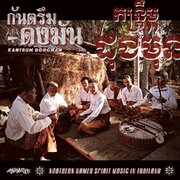- country:Thailand
- region:South East Asia
- style(s):Asian, Traditional
- label:Animist Records
- type:Small Ensemble
- gender:male
- instrumentation:instrumental, vocal, percussion, string
- artist posted by:Animist Records
Line up
- Kantrum Dongman (skor Kantrum)
Links
The group Kantrum Dongman is from the village of Dongman in Surin province in Northeast Thailand. The ensemble consists of 7 musicians of different generations.
The instruments they play consist of a few traditional drums (skor arakk, skow dai), low and high cymbals (chhing and chhap), a three-stringed fiddle called tror Khmer or tror khse bey, a double reed wind instrument called pey-aw, and singing (neak chrieng).
Their debut album provides a rare opportunity to hear a kind of music that has strong cultural significance, but was almost completely erased by the Khmer Rouge regime of Pol Pot in the Cambodia of the ‘70s.
Kantrum is not only of great value to the surviving Khmer people as part of their heritage, but is a powerful healing method in the first place.
In Khmer animism the people belief their happiness depends on the spirits that live around them. When a person becomes ill they believe the spirits are angry, and therefore need to be consoled by shaman-lead rituals with music and dance.
In the ‘90s the Khmer in Cambodia found out that a music that sounded familiair in language, melody, rhythm and instrumentation, but they didn’t know, survived on the other side of the border in Thailand.
Since then the soulful songs with deep grooving rhythms sparked a revival that has been growing steadily ever since.
One of the few surviving groups with knowledge of the original music has been recorded by Olivier Schreuder & Angkanang Pimwankum of Animist Records in the border-province Surin in Northeast-Thailand.
The duo that is also behind the esantronics of Thai-Dutch collective Apichat Pakwan, in which they present both obscure Lao & Thai songs as well as their own new compositions, now introduce another selection of Southeast Asian music to the world that is rarely heard outside of the region it comes from.





